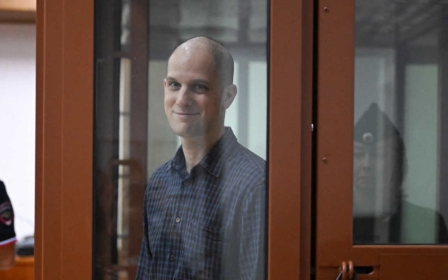‘Blood on their hands’: Report outs WSJ for unverified claims of Hamas links to Unrwa
In January, The Wall Street Journal quoted “intelligence reports” to say that 12 members of the United Nations Relief and Works Agency for Palestine Refugees in the Near East, or Unrwa, had taken part in the 7 October Hamas-led attack on southern Israel and that 10 percent of the agency’s 12,000 workers in Gaza had ties to Palestinian armed groups.
The report came only a couple of days after Israeli officials accused a dozen Unrwa workers of taking part in the attack.
The New York Times was the first to publish a detailed report on the alleged 12 Unrwa workers, but the WSJ added weight to the allegation, with its claimed findings of links between Hamas and the aid agency.
In response, the US immediately froze its funds to Unrwa, which prompted a dozen countries, including Germany and Britain, to follow suit – stalling a total of $450m. Unrwa, which was founded after the Nakba (catastrophe) for the Palestinian refugee population when the state of Israel was created, has been the main source of support for Palestinians not only in Gaza but in the West Bank, Jordan, Syria, and Lebanon as well.
New MEE newsletter: Jerusalem Dispatch
Sign up to get the latest insights and analysis on Israel-Palestine, alongside Turkey Unpacked and other MEE newsletters
In the Gaza Strip alone, the agency has operated over 183 schools (70 percent of which have now been hit by Israeli air strikes) and 22 health centres. The sudden halt of funding put additional stress on those who were displaced internally in Gaza, limiting what little access there already was to food, shelter, and medical care. The US kept its funds frozen for three months before it resumed in early April.
A recent report by Semafor said that months after the WSJ’s report, the top editor admitted the paper didn’t know – and still doesn’t know – whether its allegation was true.
In an email from earlier this year that Semafor found, WSJ chief news editor Elena Cherney wrote: “The fact that the Israeli claims haven’t been backed up by solid evidence doesn’t mean our reporting was inaccurate or misleading, that we have walked it back or that there is a correctable error here.”
According to three people familiar with the situation, the Semafor report later says that the paper's reporters “tried and failed to corroborate the 10% claim at the center of the story” and that journalists working on Middle East reportage for the publication have also raised concerns about elements of the paper’s coverage of the war more broadly – with many feeling that it is biased towards Israel.
A day after the Semafor report was published, Unrwa commissioner general Philippe Lazzarini released a statement on the internal investigation findings by the Office of Internal Oversight Services into the allegations of Unrwa staff being involved in the attack on 7 October.
Of the 19 suspected cases, 10 were dismissed and nine “may have been involved”.
"The evidence – if authenticated and corroborated – could indicate that the UNRWA staff members may have been involved in the attacks of 7 October," Philippe Lazzarini, UNRWA Commissioner-General, said in a statement on Monday.
Lazzarini proactively terminated the contracts of these nine staff members and said they will not be allowed to work with Unrwa again.
Real-world impact?
Many who have been sharing the Semafor findings have expressed their frustration with the legacy paper for being uncritical of Israel as it disseminates unverified information.
In other words, the @WSJ uncritically regurgitated Israeli disinformation in a deliberate effort to delegitimize UNRWA and prevent vital aid from reaching Palestinians in the face of an ongoing genocide. @WSJ journalists/editors have blood on their hands. https://t.co/G2FkXivqNz
— Tariq Kenney-Shawa (@tksshawa) August 5, 2024
Others have pointed out that this very report was used as justification for the killing of multiple UN members by Israel.
The editor who published that piece is partially responsible for the killings of dozens of innocent UN workers. Israel referred *to* the WSJ in their external communications as they bombed known UN staff.
— Isi Breen (@isaiah_bb) August 5, 2024
I’m sure the edit room is sleeping just fine. https://t.co/dCsg8jB7WX
Many Palestinian and Arab journalists took to social media to express that the Semafor report was not only unsurprising but was expected.
The WSJ “report” on UNRWA was used to justify the targeting & killing of hundreds of UN workers and severing the last lifeline Palestinians in Gaza had to food and clean water,
— Sana Saeed (@SanaSaeed) August 5, 2024
Several of us journalists called it out at the time for the clear propaganda it was.
Other news… https://t.co/qmVumkqqqQ
Another claim that received international attention and outrage, and has been used as a justification for Israel’s war on Gaza by world leaders like President Joe Biden, was the alleged widespread rape that occurred on 7 October. The New York Times expose, “Screams Without Words”, detailed the alleged mass rape which The Intercept soon found was based on sources that either came straight from the Israeli military or were unverified by other sources. The NYT has not retracted the expose.
For the last ten months, many online have repeatedly pointed fingers at publications like the NYT and the WSJ for spreading information from the Israeli government with little to no verification of the information. Literary Hub editor Dan Sheehan recently took to the social media platform X to say that “NYT’s ‘Screams Without Words’ and WSJ’s ‘UNRWA-is-Hamas’ are the two most harmful pieces of laundered Hasbara we’ve ever seen.”
NYT’s “Screams Without Words” and WSJ’s ‘UNRWA-is-Hamas’ are the two most harmful pieces of laundered Hasbara we’ve ever seen.
— Dan Sheehan (@danpjsheehan) August 5, 2024
Palestinians died because of them.
Will any editor involved in publishing, and refusing to retract, these pieces suffer any professional repercussions? pic.twitter.com/aPq2oFvK4M
Organisations like Writers Against the War on Gaza have made it their primary goal to put direct pressure on legacy publications like the NYT, WSJ and AP to correct any misleading headlines and information with their monthly newspaper edition, the “New York Crimes,” and have spearheaded a campaign for readers to un-subscribe to the NYT.
Since we began circulating this template yesterday (on Instagram), we have been cc'd on dozens of emails from ex-NYT readers who are unsubscribing while demanding retractions, resignations, and more. We will be sharing some of the more "in your own words" letters below.… pic.twitter.com/LXvHvCVOc1
— Writers Against the War on Gaza (@wawog_now) March 1, 2024
Middle East Eye delivers independent and unrivalled coverage and analysis of the Middle East, North Africa and beyond. To learn more about republishing this content and the associated fees, please fill out this form. More about MEE can be found here.




